Heath Star Moss Sketchbook study
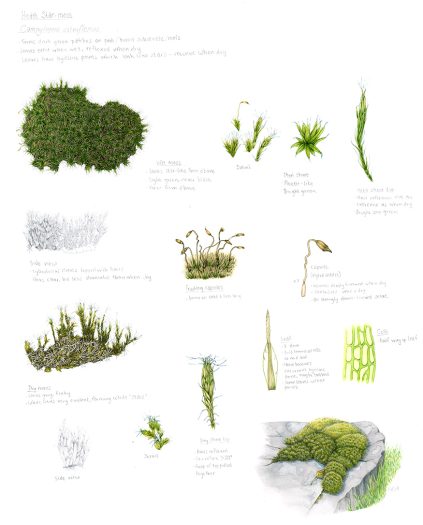
Heath star moss is one of three invasive species I’ve just illustrated for FOR in Sweden. In this case, the moss is an unwelcome invasive in Iceland, where it outcompetes other mosses and affects the delicate balance of existing ecosystems.
Sketchbook pages
FOR have commissioned several sets of invasive species over the years, and favour the sketchbook approach.
For me, this is a treat. Sketchbook studies incorporate all the important aspects of a plant that help you to identify it. However, you can pick and choose which elements to work up to a finished level. This gives me an enormous amount of freedom to play about with composition, and to focus on aspects of the plant that really interest me. There’s a gallery of these on my website, and many originals (including the Heath star moss) are available to buy.
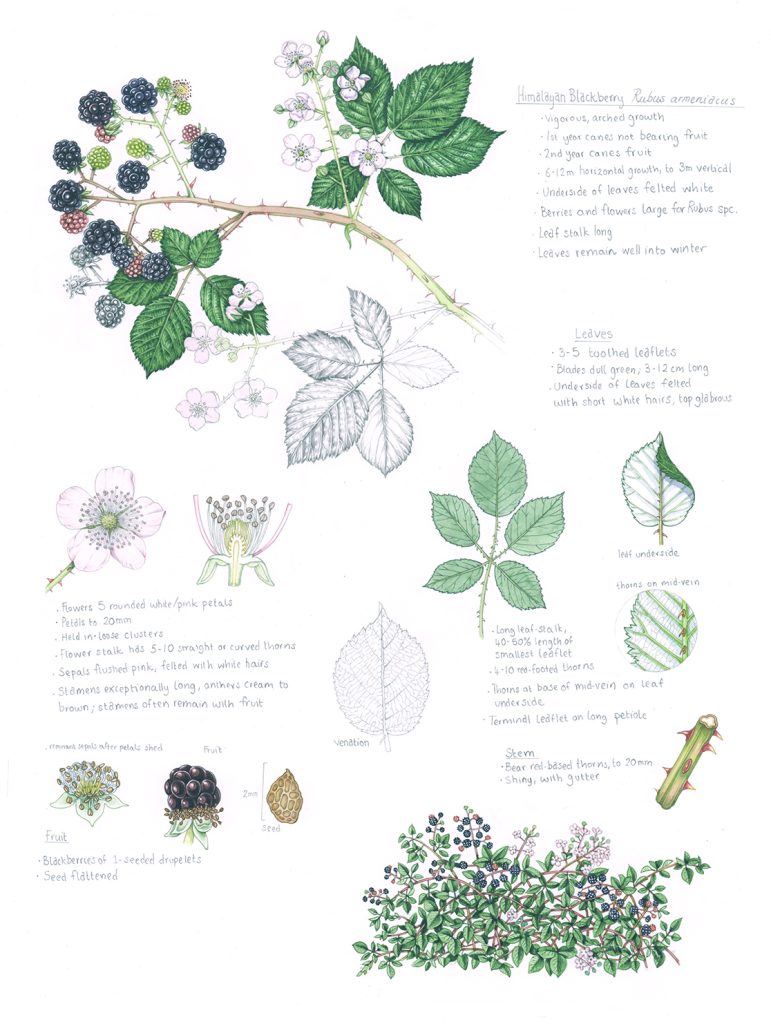
Himalayan Blackberry Rubus armeniacus for FOR
Illustrating Moss
I’ve illustrated moss before, and always enjoy it. These plants are so totally different from the normal vascular species I illustrate, and that’s one of the things I love about them. Their details are tiny, which also appeals to me. Luckily, I’ve got lots of books on moss (such as Mosses and Liverworts of Britain and Ireland by Atherton, Bosanquet, and Lawley) which are invaluable.
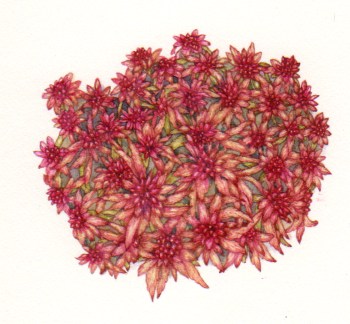
Red bog moss Sphagnum capillifolium
Anatomical details that need including are the shoots which emerge from the main body of the moss, sometimes known as the protonema. Spores and the shoots bearing them (sporophytes) need to be recorded, along with the spore capsules and their hoods (calyptra). Individual gametophyte shoots also need illustrating. Stems (also referred to as the caulid or axis) and individual leaves (phyllids) need detailing, along with information on the cellular structure of the leaves.
There seem to be quite a lot of different terms for the same structures, depending on which bryologist you ask. For this reason, do excuse any botanical mistakes I might make in this blog!
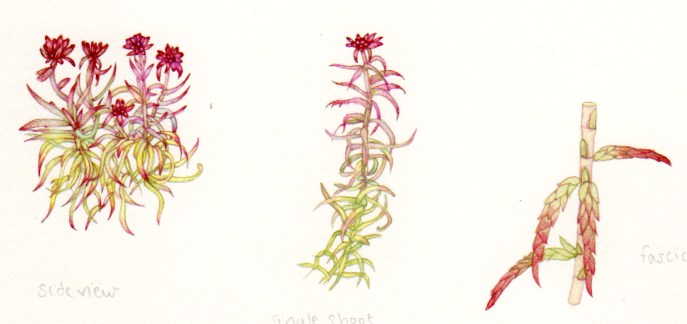
Sphagnum capillifolium details
Illustrating these elements requires pretty full on dives into my moss books, and often the community of bryologists on Twitter or the British bryological society help out. One day, I need to get one of these lovely and eminent botanists to write a guest blog on the theme “Introduction to Mosses”. It’d be invaluable for me, as well as other moss-dabblers!
Heath star moss: Specimen
The first thing to do is to get my hands on some actual Heath star moss. I’m extremely fortunate to know one Ray Woods, a top moss expert, who lives nearby. Despite the world being in Covid-19 lockdown, he found some Campylopus introflexus on his greenhouse roof and sent it to me.
Next, I drew it up in pencil and, once I got the ok from the client, could apply some colour.
Heath star moss: Is it wet…or is it dry?
One of the quirks of this particular species is that it looks totally different when it’s wet and when it’s dry. When wet, it has a bright green, star-like appearance.
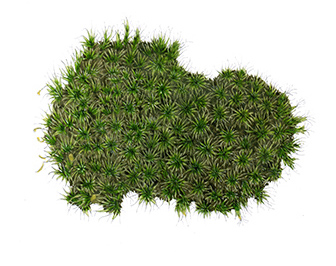
Wet Heath star moss Campylopus introflexus
When it’s dry it looks almost black, and very scaly, Each phyllid (leaflet) has a long, glassy tip. These bend at sharp angles when they’re dry. Tons of these tiny “leaves” with their white, spindly points makes a patch of Heath star moss look almost hoary. This was an absolute pain to draw, but become easier to understand, visually, once I got some colour on the illustration.
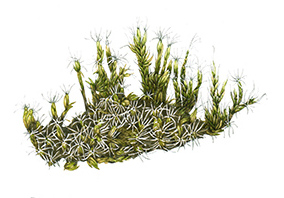
Heath star moss Campylopus introflexus
The two illustrations above are of the exact same specimen. I didn’t have a lot of the moss, so only broke off a fragment and allowed it to dry in the airing cupboard. The rest I kept moist as I needed to illustrate details of the spore capsule and phyllids, which are easier to manage when wet.
Heath star moss: Individual shoots
As well as a clump of moss, I needed to include details of the individual shoots when wet and dry. The main focus here has to be the points. I’m tempted to call them awns, as one would do if talking about grasses, but am pretty sure they have their own specific name somewhere…. These tips are always bent, but become very recurved when the moss is dry. It’s a diagnostic of the species; if these spines recurve more than 90 degrees then it’s probably the Heath star moss.
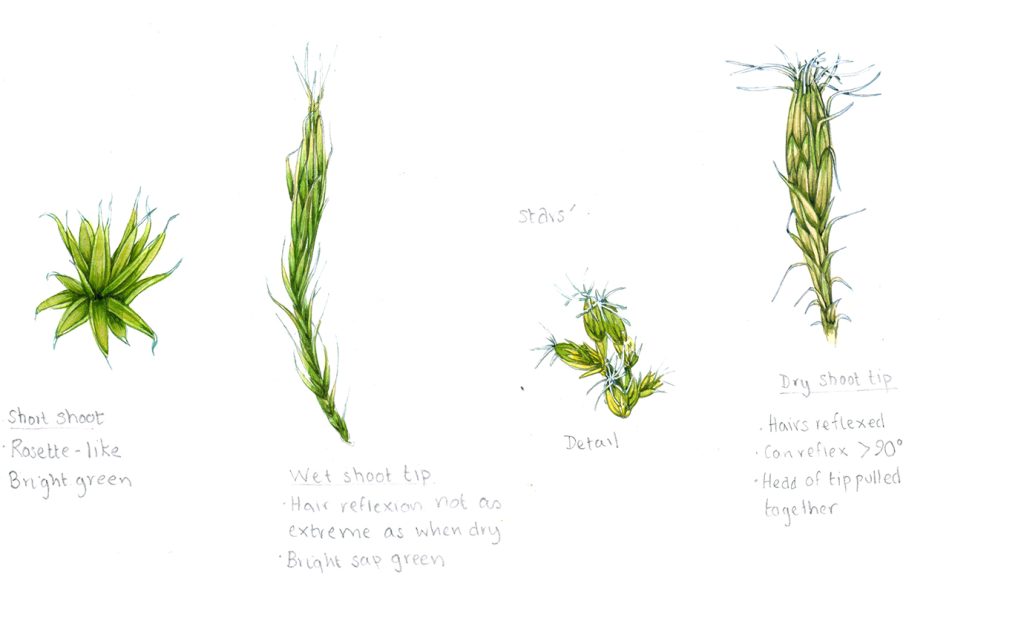
Heath star moss Campylopus introflexus shoots
I also include top views of the shoot (also referred to as a fascicle. See, I told you there were lots of different words for the same things!), although this didn’t help much with the dry specimen.
To ensure botanical honesty, these illustrations are both pf the exact same fascilce.
Heath star moss: Cellular details
The next challenge was to look at an individual phyllid. I had access to good microscopic images from the British bryological society, and thanks to Ray I could also get my compound and dissecting microscope out on real specimens. Knowing I was working with the correct species is more reassuring than I can possibly tell you. I am forever indebted to ray who has often given me labelled specimens of moss.
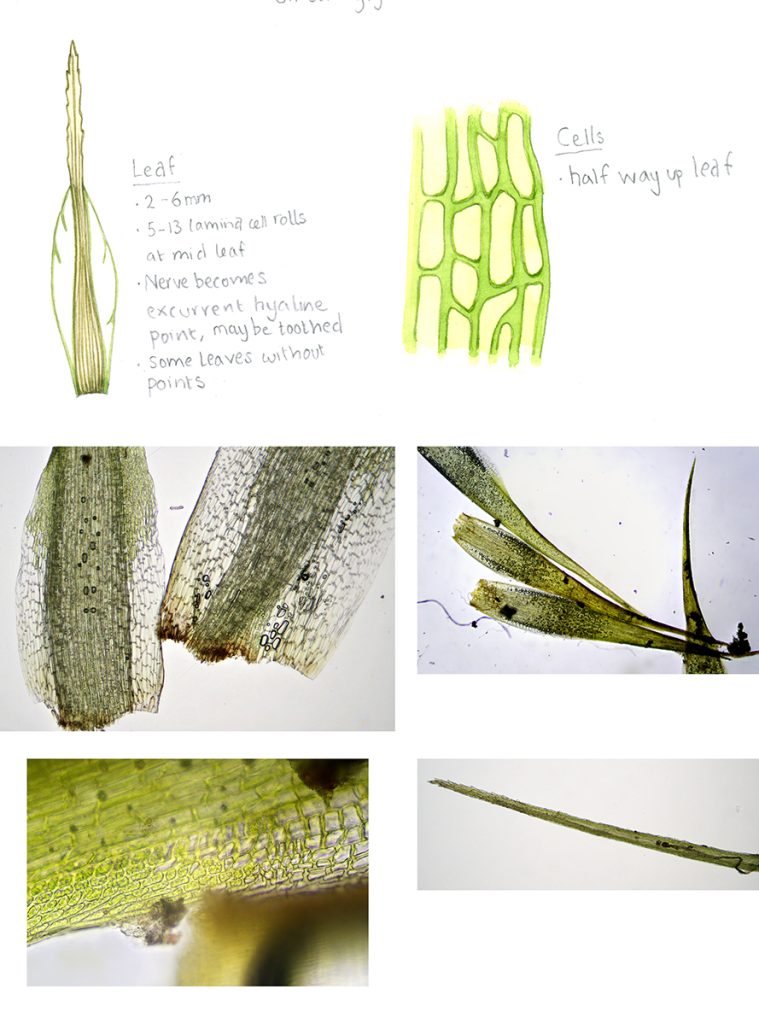
Heath star moss Campylopus introflexus microscopic details
So here is an image of an individual phyllid, and its margin under a higher magnification. I was keen to have the spine clearly included. Below are some of the British bryological society reference photos I was able to use.
The shape of the cells at the edge of the phyllid is often species specific (as in this case), hence including the detail.
Heath star moss: Sporophyte
Illustrating the sporophyte was much easier. My specimen had a few spore cases, so I had a look at them under the microscope. I couldn’t identify or get images of any spores, but decided that didn’t matter too much. The shape and colour of the spore capsule was the main thing.
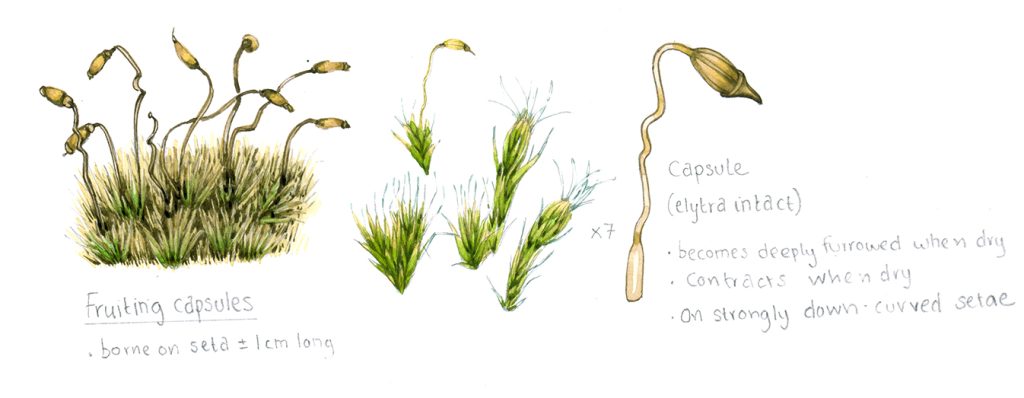
Heath star moss Campylopus introflexus sporophyte
I think the stems (caulid or axis) might be more wiggly and curled up when the specimen is dry, but as I didn’t see mention of this in the literature I decided not to make that a focus.
Heath star moss; Habit sketch
The easiest part of this sheet was completing the habit sketch. I had photos of clumps of this moss, and I had my specimen. I’ve also got a decent idea of what the limestone substrate it’s growing on looks like. It was a simple matter of collating these resources.
I added a yellow leaf for scale, and decided pretty fast that the habit sketch would be of the moss when it was wet. Drawing it dry had already made me come close to despair. In any case, it looks lovely when it’s wet and far less appealing when dried out.

Heath star moss Campylopus introflexus on stone
Conclusion
When the sheet was done, I was really pleased. It included all the required details, and hung together (more or less) as a composition.
When I illustrate moss, I take one contact lens out so I can see the detail. I leave the other one in. A week of doing this left me with my head spinning (but no headaches, luckily). I was relieved the commission was complete.
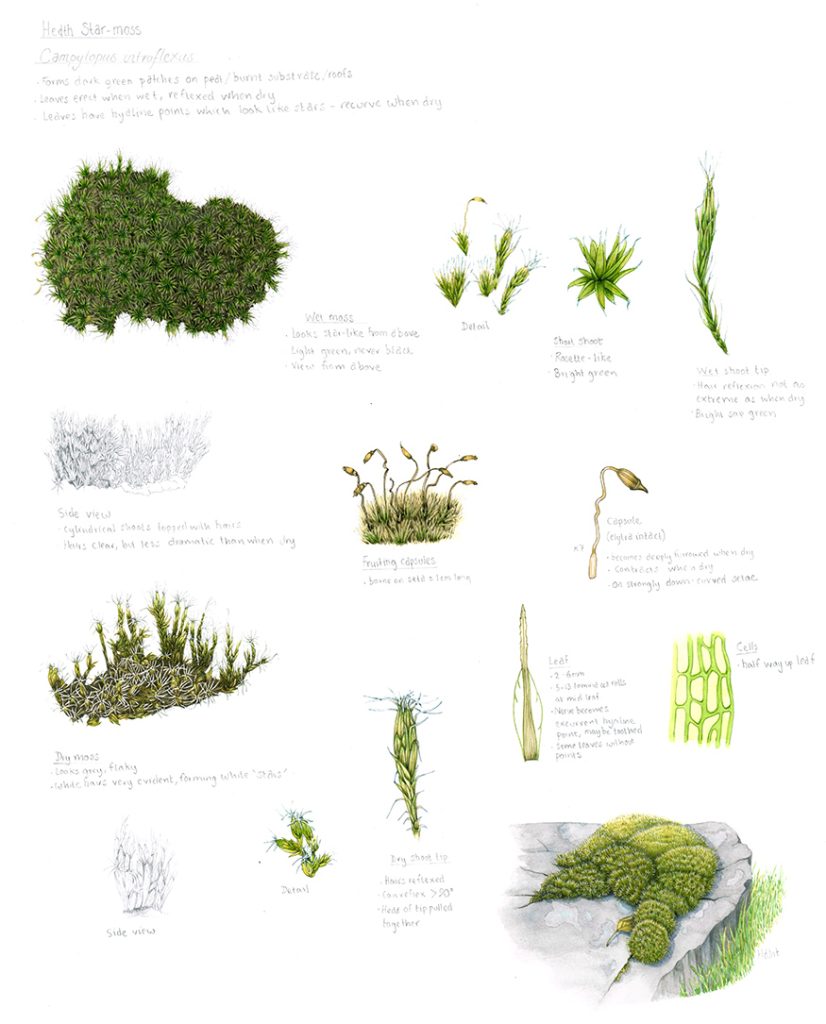
Without Ray and the British bryological society there’s no way I’d be able to illustrate mosses. And I absolutely am on the look out for someone with the skills and willingness to write a guest blog here on the basic anatomy of moss.
But for now, I just look forward to the next time an email pops into my inbox, asking for an illustration of another species of moss.
If you’d like to see how FOR have used my sketchbook studies, please take a look at the PDFs available on their website. There’s a list at the bottom right. Telling which species is which is tricky though, my Swedish isn’t any good at all!


Well done Lizzie! I enjoyed reading your blog and found it inspiring as I am also busy with a project to illustrate some moss species. Quite an overwhelming task, but oh so fascinating! I look forward to seeing more of your mosses.
Happy painting!
Thanks Daleen, and good luck with your mosses. As you say, a touch overwheleming and definitely challenging, but totally absorbing xx
Well Lizzie this is great, informative, educational and superbly drawn and painted.
Regards Peter
Hi Peter, what a lovely comment. thankyou.
You have illustrated nearly everything, the spore capsule, often with a supporting stalk (called a seta), is the sporophyte and this grows from the gametophytic stage.
Hiya, Thanks for this. I still find the anatomy of mosses challenging! Great to have your feedback.
Lizzie I enjoy reading your blogs. I go to my painting room and try to do some of the things you suggest. Thankyou
Hello there Mary! I am so glad it seems do-able and accessible. And thanks for the feedback. x
Hi Lizzie, the detailing is amazing!
What I did notice on a lot of botanical drawings c.q. Paintings I do not see the real size mentioned. Or am I missing something?
Kind regards,
Ineke
Thanks Ineke! No, youre totally right. There isnt any scale bar there and there most assuredly SHOULD be. It’s a very important thing to include, and I’m often really slack about it, which is not a good thing. By the way, Ive got a thank-you card I need to send you – could you email me your postal address on info@lizzieharper.co.uk? thanks. x